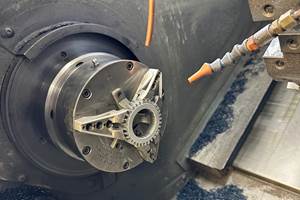Interlocking Serrated Surfaces Enhance Modular Fixturing
This pedestal-type workholding fixture matches its grooves and ridges naturally and automatically aligns the surfaces of the workpiece, making subsequent reclampings highly repeatable.
Share





Look closely at the illustration (below, left). You can see two sides of a pedestal-type workholding fixture. Each side of the pedestal features ductile iron mounting plates, with two vertical T-slots running up and down. The surface of these mounting plates is serrated; that is, the surface is lined with V-shaped grooves and ridges. These grooves and ridges are plainly visible running across the plates.
What you can’t see are the matching grooves and ridges on the mating surfaces of the fixture blocks clamped to the mounting plates. The grooves and ridges on these mating surfaces are precisely shaped and spaced so that the match between the surfaces is very nearly perfect. When these opposing grooves and ridges come together, they interlock, forming a very rigid, very firm and very level, highly repeatable interface. Matching the grooves and ridges naturally and automatically aligns the surfaces, making subsequent reclampings highly repeatable.
That’s according to the Industrial Products Division of Kurt Manufacturing Co. (Minneapolis, Minnesota). Kurt developed this system of interlocking serrated surfaces for its new family of modular workholding components, which are being marketed under the trade name of SeraLock. The system will be available to national distributors by the end of May 2000.
The company believes that these interlocking serrated surfaces will make modular workholding more effective for a larger number of applications. According to Kurt, modular workholding is already very popular in Europe and becoming more widely used in the United States. Modular workholding involves standard clamping and locating components mounted to a standard subplate to adapt to the configuration of the workpiece. A number of components may be attached to the subplate so that multiple like or unlike workpieces may be machined in the same setup. Mixing and matching the components makes it possible to create the equivalent of a custom fixture in less time than the custom fixture can be designed and produced. Because the modular components can be reconfigured and used over and over again, this approach to workholding is very economical.
Interlocking serrated surfaces enhance the modular approach by making the interfaces between system elements more flexible as well as more rigid. In Kurt’s SeraLock system, the standard patter is 16 grooves per inch. Thus, configurations of components can be repositioned by increments as small as 1/16 inch to suit the situation without losing any of the benefits of rigidity, alignment or repeatability. The matching grooves and ridges are self-aligning, no matter where the components happen to be positioned on the subplate. Likewise, the stroke of the clamping elements need not exceed 0.062 inch to fully engage the serration and prevent any unwanted movement.
The ductile iron mounting plates with serrated surfaces, which are the heart of the SeraLock system, are manufactured in pallet or multi-sided tower configurations for use on vertical or horizontal machining centers. Manual or hydraulic clamping devices with mating serration can be affixed by standard T-nut connections. The spacing, or pitch, of the serration allows the use of a variety of economical, short-stroke clamping elements. The moveable and stationary components of the clamp can be located relative to one another on the subplate such that the stroke of the moveable component need be little more than the pitch of the serration.
According to Kurt, due to the versatility inherent in the system, setups can range from high-density loads of small parts to single-station configurations for very large workpieces, all on the same workholding surface. Kurt has produced several series of fixture clamping systems, and by adding serration, all of these systems are compatible with SeraLock subplates.
These systems include the MiniLock for high-density setups of small parts; the MoveLock, a two-piece vise for independent mounting of stationary and moveable elements; and the WedgeLock, a style of fixture clamp designed for large workpieces on horizontal machining centers. Other standard machine vises can be serrated to use on SeraLock pallets and towers. Not only does this result in precise repositioning each time the vise is re-installed, but it also allows the machinist to leave the serrated subplates on the machine table when modular fixtures are not being used. ¸ßĹâÂĘÁůşĎ˛Ę
Related Content
Quick-Change Tool Heads Reduce Setup on Swiss-Type Turning Centers
This new quick-change tooling system enables shops to get more production from their Swiss turning centers through reduced tool setup time and matches the performance of a solid tool.
Read MoreChuck Jaws Achieve 77% Weight Reduction Through 3D Printing
Alpha Precision Group (APG) has developed an innovative workholding design for faster spindle speeds through sinter-based additive manufacturing.
Read MoreFive Common Mistakes Shops Make with ER Collets (And How to Prevent Them)
Collets play a crucial role in the machining process, so proper tool assembly and maintenance is important. Here are five potential pitfalls to avoid when using ER collets.
Read MoreHow to Mitigate Chatter to Boost Machining Rates
There are usually better solutions to chatter than just reducing the feed rate. Through vibration analysis, the chatter problem can be solved, enabling much higher metal removal rates, better quality and longer tool life.
Read MoreRead Next
Machine Shop MBA
Making Chips and ¸ßĹâÂĘÁůşĎ˛Ę are teaming up for a new podcast series called Machine Shop MBA—designed to help manufacturers measure their success against the industry’s best. Through the lens of the Top Shops benchmarking program, the series explores the KPIs that set high-performing shops apart, from machine utilization and first-pass yield to employee engagement and revenue per employee.
Read MoreAMRs Are Moving Into Manufacturing: 4 Considerations for Implementation
AMRs can provide a flexible, easy-to-use automation platform so long as manufacturers choose a suitable task and prepare their facilities.
Read More





















